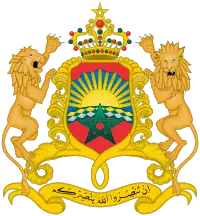Almoravid dynasty
The Almoravid dynasty (Arabic: المرابطون, Al-Murābiṭūn) was an imperial Berber Muslim dynasty centered in Morocco.[2][3] It established an empire in the 11th century that stretched over the western Maghreb and Al-Andalus. Founded by Abdallah ibn Yasin, the Almoravid capital was Marrakesh, a city the ruling house founded in 1062. The dynasty originated among the Lamtuna and the Gudala, nomadic Berber tribes of the Sahara, traversing the territory between the Draa, the Niger, and the Senegal rivers.[4]
Almoravid dynasty ⵉⵎⵔⴰⴱⴹⵏ, Imrabḍen المرابطون, Al-Murābiṭūn | |||||||||||||||
|---|---|---|---|---|---|---|---|---|---|---|---|---|---|---|---|
| 1040–1147 | |||||||||||||||
 Flag | |||||||||||||||
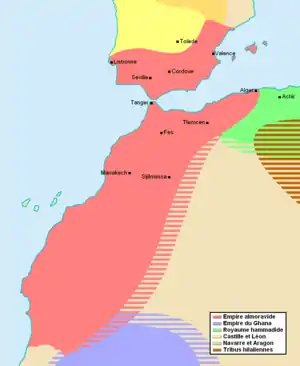 The Almoravid empire at its greatest extent, c. 1120. | |||||||||||||||
| Status | Ruling dynasty of Morocco | ||||||||||||||
| Capital | |||||||||||||||
| Common languages | Berber, Arabic, Mozarabic | ||||||||||||||
| Religion | Islam (Sunni); minority Christianity (Roman Catholic), Judaism | ||||||||||||||
| Government | Hereditary monarchy | ||||||||||||||
| Emir | |||||||||||||||
• 1040–1059 | Abdallah ibn Yasin | ||||||||||||||
• 1146–1147 | Ishaq ibn Ali | ||||||||||||||
| History | |||||||||||||||
• Established | 1040 | ||||||||||||||
• Disestablished | 1147 | ||||||||||||||
| Area | |||||||||||||||
| 1120 est.[1] | 1,000,000 km2 (390,000 sq mi) | ||||||||||||||
| Currency | Almoravid Dinar | ||||||||||||||
| |||||||||||||||
Part of a series on the |
|---|
| History of Morocco |
 |
|
|
Part of a series on the |
|---|
| History of Mauritania |
.svg.png.webp) |
|
|
The Almoravids were crucial in preventing the fall of Al-Andalus to the Iberian Christian kingdoms, when they decisively defeated a coalition of the Castilian and Aragonese armies at the Battle of Sagrajas in 1086. This enabled them to control an empire that stretched 3,000 kilometers (1,900 mi) north to south. However, the rule of the dynasty was relatively short-lived. The Almoravids fell—at the height of their power—when they failed to stop the Masmuda-led rebellion initiated by Ibn Tumart. As a result, their last king Ishaq ibn Ali was killed in Marrakesh in April 1147 by the Almohad Caliphate, who replaced them as a ruling dynasty both in Morocco and Al-Andalus.
Name
The term "Almoravid" comes from the Arabic "al-Murabit" (المرابط), through the Spanish: almorávide.[5] The transformation of the b in "al-Murabit" to the v in almorávide is an example of betacism in Spanish.
In Arabic, "al-Murabit" literally means "one who is tying" but figuratively means "one who is ready for battle at a fortress". The term is related to the notion of ribat رِباط, a North African frontier monastery-fortress, through the root r-b-t (ربط "rabat": to tie , to unite or رابط "raabat": to encamp).[6][7]
The name "Almoravid" was tied to a school of Malikite law called "Dar al-Murabitin" founded in Sus al-Aksa, modern day Morocco, by a scholar named Waggag Ibn Zallu. Ibn Zallu sent his student Abdallah ibn Yasin to preach Malikite Islam to the Sanhaja Berbers of the Sous and Adrar (present-day Mauritania). Hence, the name of the Almoravids comes from the followers of the Dar al-Murabitin, "the house of those who were bound together in the cause of God."[8]
It is uncertain exactly when or why the Almoravids acquired that appellation. al-Bakri, writing in 1068, before their apex, already calls them the al-Murabitun, but does not clarify the reasons for it. Writing three centuries later, Ibn Abi Zar suggested it was chosen early on by Abdallah ibn Yasin[9] because, upon finding resistance among the Gudala Berbers of Adrar (Mauritania) to his teaching, he took a handful of followers to erect a makeshift ribat (monastery-fortress) on an offshore island (possibly Tidra island, in the Bay of Arguin).[10] Ibn Idhari wrote that the name was suggested by Ibn Yasin in the "persevering in the fight" sense, to boost morale after a particularly hard-fought battle in the Draa valley c. 1054, in which they had taken many losses. Whichever explanation is true, it seems certain the appellation was chosen by the Almoravids for themselves, partly with the conscious goal of forestalling any tribal or ethnic identifications.
The name might be related to the ribat of Waggag ibn Zallu in the village of Aglu (near present-day Tiznit), where the future Almoravid spiritual leader Abdallah ibn Yasin got his initial training. The 13th-century Moroccan biographer Ibn al-Zayyat al-Tadili, and Qadi Ayyad before him in the 12th century, note that Waggag's learning center was called Dar al-Murabitin (The house of the Almoravids), and that might have inspired Ibn Yasin's choice of name for the movement.[11][12]
Contemporaries frequently referred to them as the al-mulathimun ("the veiled ones", from litham, Arabic for "veil"). The Almoravids veiled themselves below the eyes with a tagelmust, a custom they adapted from southern Sanhaja Berbers. (This can still be seen among the modern Tuareg people, but it was unusual further north.) Although practical for the desert dust, the Almoravids insisted on wearing the veil everywhere, as a badge of "foreignness" in urban settings, partly as a way of emphasizing their puritan credentials. It served as the uniform of the Almoravids. Under their rule, sumptuary laws forbade anybody else from wearing the veil, thereby making it the distinctive dress of the ruling class. In turn, the succeeding Almohads made a point of mocking the Almoravid veil as symbolic of effeminacy and decadence.
Origins
The Berbers of the Tamazgha in the early Middle Ages could be roughly classified into three major groups: the Zenata across the north, the Masmuda concentrated in central Morocco, and the Sanhaja, clustered in two areas: the western part of the Sahara and the hills of the eastern Maghreb.[13][14] The eastern Sanhaja included the Kutama Berbers, who had been the base of the Fatimid rise in the early 10th century, and the Zirid dynasty, who ruled Ifriqiya as vassals of the Fatimids after the latter moved to Egypt in 972. The western Sanhaja were divided into several tribes: the Gazzula and the Lamta in the Draa valley and the foothills of the Anti-Atlas range; further south, encamped in the western Sahara, were the Massufa, the Lamtuna and the Banu Warith; and most southerly of all, the Gudala, in littoral Mauritania down to the borderlands of the Senegal River.
The western Sanhaja had been converted to Islam some time in the 9th century. They were subsequently united in the 10th century and, with the zeal of new converts, launched several campaigns against the "Sudanese" (pagan peoples of sub-Saharan Africa).[15] Under their king Tinbarutan ibn Usfayshar, the Sanhaja Lamtuna erected (or captured) the citadel of Awdaghust, a critical stop on the trans-Saharan trade route. After the collapse of the Sanhaja union, Awdagust passed over to the Ghana empire; and the trans-Saharan routes were taken over by the Zenata Maghrawa of Sijilmassa. The Maghrawa also exploited this disunion to dislodge the Sanhaja Gazzula and Lamta out of their pasturelands in the Sous and Draa valleys. Around 1035, the Lamtuna chieftain Abu Abdallah Muhammad ibn Tifat (alias Tarsina), tried to reunite the Sanhaja desert tribes, but his reign lasted less than three years.
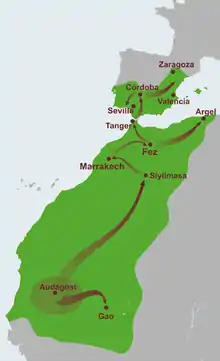
Around 1040, Yahya ibn Ibrahim, a chieftain of the Gudala (and brother-in-law of the late Tarsina), went on pilgrimage to Mecca. On his return, he stopped by Kairouan in Ifriqiya, where he met Abu Imran al-Fasi, a native of Fes and a jurist and scholar of the Sunni Maliki school. At this time, Ifriqiya was in ferment. The Zirid ruler al-Muizz ibn Badis, was openly contemplating breaking with his Shi'ite Fatimid overlords in Cairo, and the jurists of Kairouan were agitating for him to do so. Within this heady atmosphere, Yahya and Abu Imran fell into conversation on the state of the faith in their western homelands, and Yahya expressed his disappointment at the lack of religious education and negligence of Islamic law among his southern Sanhaja people. With Abu Imran's recommendation, Yahya ibn Ibrahim made his way to the ribat of Waggag ibn Zelu in the Sous valley of southern Morocco, to seek out a Maliki teacher for his people. Waggag assigned him one of his residents, Abdallah ibn Yasin.
Abdallah ibn Yasin was a Gazzula Berber, and probably a convert rather than a born Muslim. His name can be read as "son of Ya Sin" (the title of the 36th Sura of the Qur'an), suggesting he had obliterated his family past and was "re-born" of the Holy Book.[16] Ibn Yasin certainly had the ardor of a puritan zealot; his creed was mainly characterized by a rigid formalism and a strict adherence to the dictates of the Qur'an, and the Orthodox tradition.[17] (Chroniclers such as al-Bakri allege Ibn Yasin's learning was superficial.) Ibn Yasin's initial meetings with the Gudala people went poorly. As he had more ardor than depth, Ibn Yasin's arguments were disputed by his audience. He responded to questioning with charges of apostasy and handed out harsh punishments for the slightest deviations. The Gudala soon had enough and expelled him almost immediately after the death of his protector, Yahya ibn Ibrahim, sometime in the 1040s.
Ibn Yasin, however, found a more favorable reception among the neighboring Lamtuna people.[17] Probably sensing the useful organizing power of Ibn Yasin's pious fervor, the Lamtuna chieftain Yahya ibn Umar al-Lamtuni invited the man to preach to his people. The Lamtuna leaders, however, kept Ibn Yasin on a careful leash, forging a more productive partnership between them. Invoking stories of the early life of Muhammad, Ibn Yasin preached that conquest was a necessary addendum to Islamicization, that it was not enough to merely adhere to God's law, but necessary to also destroy opposition to it. In Ibn Yasin's ideology, anything and everything outside of Islamic law could be characterized as "opposition". He identified tribalism, in particular, as an obstacle. He believed it was not enough to urge his audiences to put aside their blood loyalties and ethnic differences, and embrace the equality of all Muslims under the Sacred Law, it was necessary to make them do so. For the Lamtuna leadership, this new ideology dovetailed with their long desire to refound the Sanhaja union and recover their lost dominions. In the early 1050s, the Lamtuna, under the joint leadership of Yahya ibn Umar and Abdallah ibn Yasin—soon calling themselves the al-Murabitin (Almoravids)—set out on a campaign to bring their neighbors over to their cause.
Conquests
Northern Africa
From the year 1053, the Almoravids began to spread their religious way to the Berber areas of the Sahara, and to the regions south of the desert. After winning over the Sanhaja Berber tribe, they quickly took control of the entire desert trade route, seizing Sijilmasa at the northern end in 1054, and Aoudaghost at the southern end in 1055. Yahya ibn Umar was killed in a battle in 1057,[18] but Abdullah ibn Yasin, whose influence as a religious teacher was paramount, named his brother Abu Bakr ibn Umar as chief. Under him, the Almoravids soon began to spread their power beyond the desert, and conquered the tribes of the Atlas Mountains. They then came in contact with the Berghouata, a Berber tribal confederation, who followed an Islamic "heresy" preached by Salih ibn Tarif three centuries earlier. The Berghouata resisted. Abdullah ibn Yasin was killed in battle with them in 1059, in Krifla, a village near Rommani, Morocco. They were, however, completely conquered by Abu Bakr ibn Umar, and were forced to convert to orthodox Islam.[19] Abu Bakr married a noble and wealthy Berber woman, Zaynab an-Nafzawiyyat, who would become very influential in the development of the dynasty.[20] Zaynab was the daughter of a wealthy merchant from Houara, who was said to be from Kairouan.[20]
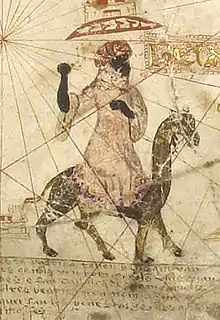
In 1061, Abu Bakr ibn Umar made a division of the power he had established, handing over the more-settled parts to his cousin Yusuf ibn Tashfin as viceroy, and also assigning to him his favourite wife Zaynab. Ibn Umar kept the task of suppressing the revolts that had broken out in the desert. When he returned to resume control, he found his cousin too powerful to be superseded.[19] In November 1087,[21] Abu Bakr was killed in battle – according to oral tradition by an arrow,[22][23] while fighting in the historic region of the Sudan.[21]
Yusuf ibn Tashfin had in the meantime brought the large area of what is now known as Morocco, Western Sahara, and Mauritania into complete subjection. In 1062 he founded the city of Marrakech. In 1080, he conquered the kingdom of Tlemcen (in modern-day Algeria) and founded the present city of that name, his rule extending as far east as Oran.[19]
Ghana Empire and the southern wing
According to Arab tradition, the Almoravids conquered the Ghana Empire sometime around 1076 CE.[24] An example of this tradition is the record of historian Ibn Khaldun, who cited Shaykh Uthman, the faqih of Ghana, writing in 1394. According to this source, the Almoravids weakened Ghana and collected tribute from the Sudan, to the extent that the authority of the rulers of Ghana dwindled away, and they were subjugated and absorbed by the Susu, a neighboring people of the Sudan.[25] Traditions in Mali related that the Soso attacked and took over Mali as well, and the ruler of the Soso, Sumaouro Kanté, took over the land.[26]
However criticism from Conrad and Fisher (1982) argued that the notion of any Almoravid military conquest at its core is merely perpetuated folklore, derived from a misinterpretation or naive reliance on Arabic sources.[27] According to Professor Timothy Insoll, the archaeology of ancient Ghana simply does not show the signs of rapid change and destruction that would be associated with any Almoravid-era military conquests.[28]
Dierke Lange agreed with the original military incursion theory but argues that this doesn't preclude Almoravid political agitation, claiming that the main factor of the demise of Ghana empire owed much to the latter.[29] According to Lange, the Almoravid religious influence was gradual and not heavily involved in military strife; there the Almoravids increased in power by marrying among the nation's nobility. Lange attributes the decline of ancient Ghana to numerous unrelated factors, only one of which can be likely attributable to internal dynastic struggles that were instigated by Almoravid influence and Islamic pressures, but devoid of military conversion and conquest.[30]
This interpretation of events has been disputed by later scholars like Sheryl L. Burkhalter (1992), who argued that, whatever the nature of the "conquest" in the south of the Sahara, the influence and success of the Almoravid movement in securing west African gold and circulating it widely necessitated a high degree of political control,.[31]
The traditional position says that the ensuing war with the Almoravids pushed Ghana over the edge, ending the kingdom's position as a commercial and military power by 1100. It collapsed into tribal groups and chieftaincies, some of which later assimilated into the Almoravids while others founded the Mali Empire.
The Arab geographer Al-Zuhri wrote that the Almoravids ended Ibadism in Tadmekka in 1084 and that Abu Bakr "arrived at the mountain of gold" in the deep south. After the death of Abu Bakr (1087), the confederation of Berber tribes in the Sahara was divided between the descendants of Abu Bakr and his brother Yahya, and would have lost control of Ghana.[32] Sheryl Burkhalter suggests that Abu Bakr's son Yahya was the leader of the Almoravid expedition that conquered Ghana in 1076, and that the Almoravids would have survived the loss of Ghana and the defeat in the Maghreb by the Almohads, and would have ruled the Sahara until the end of the 12th century.[33]
Southern Iberia and the northern wing
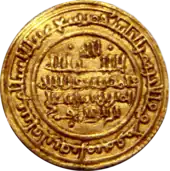
In 1086 Yusuf ibn Tashfin was invited by the Muslim taifa princes of Al-Andalus in the Iberian Peninsula to defend their territories from the encroachment of Alfonso VI, King of León and Castile. In that year, Ibn Tashfin crossed the Strait of Gibraltar to Algeciras, and defeated Castile at the Battle of az-Zallaqah (Battle of Sagrajas). He was prevented from following up his victory by trouble in Africa, which he chose to settle in person.
He returned to Iberia in 1090, avowedly for the purpose of annexing the taifa principalities of Iberia. He was supported by most of the Iberian people, who were discontented with the heavy taxation imposed upon them by their spendthrift rulers.[19] Their religious teachers, as well as others in the east, (most notably, al-Ghazali in Persia and al-Tartushi in Egypt, who was himself an Iberian by birth from Tortosa), detested the taifa rulers for their religious indifference. The clerics issued a fatwa (a non-binding legal opinion) that Yusuf was of sound morals and had the religious right to dethrone the rulers, whom he saw as heterodox in their faith. By 1094, Yusuf had annexed most of the major taifas, with the exception of the one at Saragossa. The Almoravids were victorious at the Battle of Consuegra, during which the son of El Cid, Diego Rodríguez, perished. Alfonso, with some Leónese, retreated into the castle of Consuegra, which was besieged for eight days until the Almoravids withdrew to the south.
After friendly correspondence with the caliph at Baghdad, whom he acknowledged as Amir al-Mu'minin ("Commander of the Faithful"), Yusuf ibn Tashfin in 1097 assumed the title of Amir al Muslimin ("Commander of the Muslims"). He died in 1106, when he was reputed to have reached the age of 100. The Almoravid power was at its height at Yusuf's death: the Moorish empire then included all of Northwest Africa as far eastward as Algiers, and all of Iberia south of the Tagus and as far eastward as the mouth of the Ebro, and including the Balearic Islands.[34]
In 1108 Tamim Al Yusuf defeated the Kingdom of Castile at the Battle of Uclés. Yusuf did not reconquer much territory from the Christian kingdoms, except that of Valencia; but he did hinder the progress of the Christian Reconquista by uniting al-Andalus. In 1134 at the Battle of Fraga the Almoravids dynasty was victorious and even succeeded in slaying Alfonso I of Aragon in the battle.
Culture
Religion
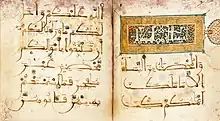
The Almoravid movement started as a conservative Islamic reform movement inspired by the Maliki school of jurisprudence.[35] The writings of Abu Imran al-Fasi, a Moroccan Maliki scholar, influenced Yahya Ibn Ibrahim and the early Almoravid movement.[36][37]
Art
At first, the Almoravids, subscribing to the conservative Maliki school of Islamic jurisprudence, rejected what they perceived as decadence and a lack of piety among the Iberian Muslims of the Andalusi Ta'ifa kingdoms.[37] However, monuments and textiles from Almería from the late Almoravid period indicate that the empire had changed its attitude with time.[37]
One of the finest remaining artifacts of the Almoravid period is the Almoravid minbar from the Kutubiyya Mosque, a minbar commissioned by Ali ibn Yusuf in 1137 and crafted by artisans in Córdoba.[38]
Almoravid Kufic is the variety of Maghrebi Kufic script used as an official display script during the Almoravid period.[39]
_(cropped).jpg.webp) The Pisa Griffin, believed to have originated in 11th century Iberia.[40]
The Pisa Griffin, believed to have originated in 11th century Iberia.[40]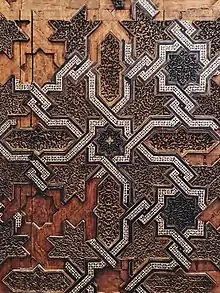 Detail of the Almoravid minbar, commissioned by Ali Bin Yusuf Bin Tashfin al-Murabiti 1137 for his great mosque in Marrakesh.
Detail of the Almoravid minbar, commissioned by Ali Bin Yusuf Bin Tashfin al-Murabiti 1137 for his great mosque in Marrakesh.
Architecture
The Almoravid period, along with the subsequent Almohad period, is considered one of the most formative stages of Moroccan and Moorish architecture, establishing many of the forms and motifs of this style that were refined in subsequent centuries.[41][42][43][44] The Almoravids were responsible for establishing a new imperial capital at Marrakesh, which became a major center of architectural patronage thereafter. The Almoravids adopted the architectural developments of al-Andalus, such as the complex interlacing arches of the Great Mosque in Cordoba and of the Aljaferia palace in Zaragoza, while also introducing new ornamental techniques from the east such as muqarnas ("stalactite" or "honeycomb" carvings).[42][45]
After taking control of Al-Andalus in the Battle of Sagrajas, the Almoravids sent Muslim, Christian and Jewish artisans from Iberia to North Africa to work on monuments.[46] The Great Mosque in Algiers (c. 1097), the Great Mosque of Tlemcen (1136) and al-Qarawiyyin (expanded in 1135) in Fes are important examples of Almoravid architecture.[47] The Almoravid Qubba is one of the few Almoravid monuments in Marrakesh surviving.
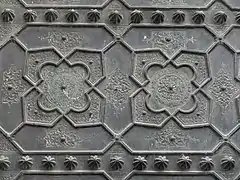 Detail of the Almoravid-era bronze overlays on the doors of al-Qarawiyiin's Bab al-Gna'iz.[48]
Detail of the Almoravid-era bronze overlays on the doors of al-Qarawiyiin's Bab al-Gna'iz.[48].jpg.webp) The Almoravid Qubba in Marrakesh.
The Almoravid Qubba in Marrakesh.
Literature
_Al-Mu%E2%80%99tamid.jpg.webp)
Moroccan literature flourished in the Almoravid period. The political unification of Morocco and al-Andalus under the Almoravid dynasty rapidly accelerated the cultural interchange between the two continents, beginning when Yusuf Bin Tashfiin sent al-Mu'tamid Bin Abbad, former poet king of the Taifa of Seville, into exile in Tangier and ultimately Aghmat.[49]
The historians Ibn Hayyan, Al-Bakri, Ibn Bassam, and al-Fath ibn Khaqan all lived in the Almoravid period.
In the Almoravid period two writers stand out: Ayyad ben Moussa and Ibn Bajja. Ayyad is known for having authored Kitāb al-Shifāʾ bīTaʾrif Ḥuqūq al-Muṣṭafá.[50] Many of the Seven Saints of Marrakesh were men of letters.
The muwashshah was an important form of poetry and music in the Almoravid period. Great poets from the period are mentioned in anthologies such as Kharidat al Qasar,[51] Al Mutrib, and Mu'jam as-Sifr.[52]
The Moroccan historian Muhammad al-Manuni noted that there were 104 paper mills in Fes under Yusuf Ibn Tashfin in the 11th century.[53]
Decline
Under Yusuf's son and successor, Ali ibn Yusuf, Sintra and Santarém were added, and he invaded Iberia again in 1119 and 1121, but the tide had turned, as the French had assisted the Aragonese to recover Zaragoza. In 1138, Ali ibn Yusuf was defeated by Alfonso VII of León, and in the Battle of Ourique (1139), by Afonso I of Portugal, who thereby won his crown. Lisbon was conquered by the Portuguese in 1147.[54]
According to some scholars, Ali ibn Yusuf was a new generation of leadership that had forgotten the desert life for the comforts of the city.[55] He was defeated by the combined action of his Christian foes in Iberia and the agitation of Almohads (the Muwahhids) in Morocco. After Ali ibn Yusuf's death in 1143, his son Tashfin ibn Ali lost ground rapidly before the Almohads. In 1146 he was killed in a fall from a precipice while attempting to escape after a defeat near Oran.[54]
His two successors were Ibrahim ibn Tashfin and Ishaq ibn Ali, but their reigns were short. The conquest of the city of Marrakech by the Almohads in 1147 marked the fall of the dynasty, though fragments of the Almoravids continued to struggle throughout the empire.[54] Among these fragments, there was the rebel Yahya Al-Sahrāwiyya, who resisted Almohad rule in the Maghrib for eight years after the fall of Marrakech before surrendering in 1155.[56] Also in 1155, the remaining Almoravids were forced to retreat to the Balearic Islands and later Ifriqiya under the leadership of the Banu Ghaniya, who were eventually influential in the downfall of their conquerors, the Almohads, in the Eastern part of the Maghrib.[57]
Military organization
Abdallah ibn Yassin imposed very strict discipline measures on his forces for every breach of his laws.[58] The Almoravids' first military leader, Yahya ibn Umar al-Lamtuni, gave them a good military organization. Their main force was infantry, armed with javelins in the front ranks and pikes behind, which formed into a phalanx;[59] and was supported by camelmen and horsemen on the flanks.[19][59] They also had a flag carrier at the front who guided the forces behind him; when the flag was upright, the combatants behind would stand and when it was turned down, they would sit.[59]
Al-Bakri reports that, while in combat, the Almoravids did not pursue those who fled in front of them.[59] Their fighting was intense and they did not retreat when disadvantaged by an advancing opposing force; they preferred death over defeat.[59] These characteristics were possibly unusual at the time.[59]
Almoravids dynasty
Rulers
- Abdallah ibn Yasin (1040–1059) – founder & spiritual leader
- Yahya ibn Ibrahim (1048)
- Yahya ibn Umar al-Lamtuni (c. 1050–1056)
- Abu Bakr ibn Umar (1056–1087) – partitioned reign from 1072.
- Yusuf ibn Tashfin (c. 1072–1106)
- Ali ibn Yusuf (1106–43)
- Tashfin ibn Ali (1143–45)
- Ibrahim ibn Tashfin (1145–1147)
- Ishaq ibn Ali (1147)
Family tree
| Almoravid family tree | |||||||||||||||||||||||||||||||||||||||||||||||||||||||||||||||||||||||||||||||||||||||||||||||||||||||||||||||||||||||||||||||||||||||||||||||||||||||||||||||||||||||||||||||||||||||||||||||||||||||||||||||||||||||||||||||||||||||||||||||||||||||||||||||||||||||||||||||||||||||||||||||||||||||||||||||||||||||||||||||||||||||||||||||||||||||||||||||||||||||||||||||||||||||||||||||||||||||||||||||||||||||||||||||||||||||||||||||||||||||||||||||||||||||||||||||||||||||||||||||||||||||||||||||||||||||||||||||||||||||||||||||||||||||||||||||||||||||||||||||||||||||||||||||||||||||||||||||||||||||||||||||||||||||||||||||||||||||||||||||||||||||||||||||||||||||||||||||||||||||||||||||||||||||||||||||||||||||||||||||||||||||||||||||||||||||||||||||||||||||||||||||||||||||||||||||||||||||||||||||||||||||||||||||||||||||||||||||||||||||||||||||||||||||||||||||||||||||||||||||||||||||||||||||||||||||||||||||||||||||||||||||||||||||||||||||||||||||||||||||||||||||||||||||||||||||||||||||||||||||
|---|---|---|---|---|---|---|---|---|---|---|---|---|---|---|---|---|---|---|---|---|---|---|---|---|---|---|---|---|---|---|---|---|---|---|---|---|---|---|---|---|---|---|---|---|---|---|---|---|---|---|---|---|---|---|---|---|---|---|---|---|---|---|---|---|---|---|---|---|---|---|---|---|---|---|---|---|---|---|---|---|---|---|---|---|---|---|---|---|---|---|---|---|---|---|---|---|---|---|---|---|---|---|---|---|---|---|---|---|---|---|---|---|---|---|---|---|---|---|---|---|---|---|---|---|---|---|---|---|---|---|---|---|---|---|---|---|---|---|---|---|---|---|---|---|---|---|---|---|---|---|---|---|---|---|---|---|---|---|---|---|---|---|---|---|---|---|---|---|---|---|---|---|---|---|---|---|---|---|---|---|---|---|---|---|---|---|---|---|---|---|---|---|---|---|---|---|---|---|---|---|---|---|---|---|---|---|---|---|---|---|---|---|---|---|---|---|---|---|---|---|---|---|---|---|---|---|---|---|---|---|---|---|---|---|---|---|---|---|---|---|---|---|---|---|---|---|---|---|---|---|---|---|---|---|---|---|---|---|---|---|---|---|---|---|---|---|---|---|---|---|---|---|---|---|---|---|---|---|---|---|---|---|---|---|---|---|---|---|---|---|---|---|---|---|---|---|---|---|---|---|---|---|---|---|---|---|---|---|---|---|---|---|---|---|---|---|---|---|---|---|---|---|---|---|---|---|---|---|---|---|---|---|---|---|---|---|---|---|---|---|---|---|---|---|---|---|---|---|---|---|---|---|---|---|---|---|---|---|---|---|---|---|---|---|---|---|---|---|---|---|---|---|---|---|---|---|---|---|---|---|---|---|---|---|---|---|---|---|---|---|---|---|---|---|---|---|---|---|---|---|---|---|---|---|---|---|---|---|---|---|---|---|---|---|---|---|---|---|---|---|---|---|---|---|---|---|---|---|---|---|---|---|---|---|---|---|---|---|---|---|---|---|---|---|---|---|---|---|---|---|---|---|---|---|---|---|---|---|---|---|---|---|---|---|---|---|---|---|---|---|---|---|---|---|---|---|---|---|---|---|---|---|---|---|---|---|---|---|---|---|---|---|---|---|---|---|---|---|---|---|---|---|---|---|---|---|---|---|---|---|---|---|---|---|---|---|---|---|---|---|---|---|---|---|---|---|---|---|---|---|---|---|---|---|---|---|---|---|---|---|---|---|---|---|---|---|---|---|---|---|---|---|---|---|---|---|---|---|---|---|---|---|---|---|---|---|---|---|---|---|---|---|---|---|---|---|---|---|---|---|---|---|---|---|---|---|---|---|---|---|---|---|---|---|---|---|---|---|---|---|---|---|---|---|---|---|---|---|---|---|---|---|---|---|---|---|---|---|---|---|---|---|---|---|---|---|---|---|---|---|---|---|---|---|---|---|---|---|---|---|---|---|---|---|---|---|---|---|---|---|---|---|---|---|---|---|---|---|---|---|---|---|---|---|---|---|---|---|---|---|---|---|---|---|---|---|---|---|---|---|---|---|---|---|---|---|---|---|---|---|---|---|---|---|---|---|---|---|---|---|---|---|---|---|---|---|---|---|---|---|---|---|---|---|---|---|---|---|---|---|---|---|---|---|---|---|---|---|---|---|---|---|---|---|---|---|---|---|---|---|---|---|---|---|---|---|---|---|---|---|---|---|---|---|---|---|---|---|---|---|---|---|---|---|---|---|---|---|---|---|---|---|---|---|---|---|---|---|---|---|---|---|---|---|---|---|---|---|---|---|---|---|---|---|---|---|---|---|---|---|---|---|---|---|---|---|---|---|---|---|---|---|---|---|---|---|---|---|---|---|---|---|---|---|---|---|---|---|---|---|---|---|---|---|---|---|---|---|---|---|---|---|---|---|---|---|---|---|---|---|---|---|---|---|---|---|---|---|---|---|---|---|---|---|---|---|---|---|---|---|---|---|---|---|---|---|---|---|---|---|---|---|---|---|---|---|---|---|---|---|---|---|---|---|---|---|---|---|---|---|---|---|---|---|---|---|---|---|---|---|---|---|---|---|---|---|---|---|---|---|---|---|---|---|---|---|---|---|---|---|---|---|---|---|---|---|---|---|---|---|---|---|---|---|---|---|---|---|---|---|---|---|---|---|---|---|---|---|---|---|---|---|---|---|---|---|---|---|---|---|---|---|---|---|---|---|---|---|---|---|---|---|---|---|---|---|---|---|---|---|---|---|---|---|---|---|---|---|---|
| |||||||||||||||||||||||||||||||||||||||||||||||||||||||||||||||||||||||||||||||||||||||||||||||||||||||||||||||||||||||||||||||||||||||||||||||||||||||||||||||||||||||||||||||||||||||||||||||||||||||||||||||||||||||||||||||||||||||||||||||||||||||||||||||||||||||||||||||||||||||||||||||||||||||||||||||||||||||||||||||||||||||||||||||||||||||||||||||||||||||||||||||||||||||||||||||||||||||||||||||||||||||||||||||||||||||||||||||||||||||||||||||||||||||||||||||||||||||||||||||||||||||||||||||||||||||||||||||||||||||||||||||||||||||||||||||||||||||||||||||||||||||||||||||||||||||||||||||||||||||||||||||||||||||||||||||||||||||||||||||||||||||||||||||||||||||||||||||||||||||||||||||||||||||||||||||||||||||||||||||||||||||||||||||||||||||||||||||||||||||||||||||||||||||||||||||||||||||||||||||||||||||||||||||||||||||||||||||||||||||||||||||||||||||||||||||||||||||||||||||||||||||||||||||||||||||||||||||||||||||||||||||||||||||||||||||||||||||||||||||||||||||||||||||||||||||||||||||||||||||
Timeline

Notes
- Turchin, Peter; Adams, Jonathan M.; Hall, Thomas D. (December 2006). "East-West Orientation of Historical Empires". Journal of World-systems Research. 12: 222–223. ISSN 1076-156X. Retrieved 1 August 2020..
- G. Stewart, Is the Caliph a Pope?, in: The Muslim World, Volume 21, Issue 2, pages 185–196, April 1931: "The Almoravid dynasty, among the Berbers of North Africa, founded a considerable empire, Morocco being the result of their conquests"
- Sadiqi, Fatima, The place of Berber in Morocco, International Journal of the Sociology of Language, 123.1 (2009): 7–22 : "The Almoravids were the first relatively recent Berber dynasty that ruled Morocco. The leaders of this dynasty came from the Moroccan deep south."
- Extract from Encyclopedia Universalis on Almoravids.
- "Almoravid | Definition of Almoravid by Lexico". Lexico Dictionaries | English. Retrieved 15 October 2019.
- Nehemia Levtzion, "Abd Allah b. Yasin and the Almoravids", in: John Ralph Willis, Studies in West African Islamic History, p. 54.
- P. F. de Moraes Farias, "The Almoravids: Some Questions Concerning the Character of the Movement", Bulletin de l’IFAN, series B, 29: 3–4 (794–878), 1967.
- Messier, Ronald A. The Almoravids and the meanings of jihad, Santa Barbara, CA. Praeger Publishers, 2010.
- Ibn Abi Zar, p. 81.
- Ibn Abi Zar's account is translated in N. Levtzion and J. F. P. Hopkins, eds (2000), Corpus of Early Arabic Sources for West African History, University of Ghana,pp. 239ff. For tentative identification of the ribat, see Moraes Farias (1967).
- Ibn al-Zayyat (1220). التشوف إلى معرفة رجال التصوف [Looking to know the men of Sufism]. p. 89.
- Qadi Ayyad. ترتيب المدارك وتنوير المسالك لمعرفة أعلام مذهب مالك [Biographies of Eminent Maliki Scholars]. pp. 839–40.
- ʻAbd al-Wāḥid Dhannūn Ṭāhā (1998). The Muslim conquest and settlement of North Africa and Spain. Routledge. ISBN 0-415-00474-8. (online at Google Books)
- Mones (1988), p. 119; (1992), p. 228.
- Lewicki (1988), pp. 160–61; (1992), pp. 308–09.
- M. Brett and E. Fentress (1996), The Berbers, Oxford: Blackwell, p. 100. Revealingly, the 36th Sura begins the salutation "You are one of messengers" and the imperative duty to set people "on the straight path". Ibn Yasin's choice of name was probably not a coincidence.
- Shillington, Kevin (2005). History of Africa. New York: Palgrave Macmillan. p. 88. ISBN 978-0-333-59957-0.
- Shillington, p. 90.
- Chisholm 1911, p. 717.
- Ibn Abi Zar, p. 87.
- Ibn Abi Zar, p. 89.
- P. Semonin (1964) "The Almoravid Movement in the Western Sudan: A review of the evidence" Transactions of the Historical Society of Ghana, v.7: p.58
- R.A. Messier (2010) The Almoravids and the Meanings of Jihad, Sant Barbar: Praeger. p.209
- Robinson, David. Muslim Societies in African History (New approaches to African History)
- Ibn Khaldun in Levtzion and Hopkins, eds. and transl. Corpus, p. 333.
- Nehemia Levtzion, Ancient Ghana and Mali (New York, 1973), pp. 51–2; 58–60.
- Masonen & Fisher 1996.
- Insoll 2003, p. 230.
- Lange 1996, pp. 122–59.
- Lange, Dierk (1996). "The Almoravid expansion and the downfall of Ghana". Der Islam. 73 (73): 122–159. doi:10.1515/islm.1996.73.2.313. S2CID 162370098..
- Gómez-Rivas, Camilo. Law and the Islamization of Morocco under the Almoravids, p. 13.
- The Cambridge History of Africa, Volume 3: From c.1050 to c.1600
- Burkhalter, Sheryl L. Listening for Silences in Almoravid History: Another Reading of “The Conquest That Never Was"
- Chisholm 1911, pp. 717–718.
- "Almoravids | Berber confederation". Encyclopedia Britannica. Retrieved 8 June 2020.
- Pellat, Ch. (2004). "Abū ʿImrān al-Fāsī". In Bearman, P.; Bianquis, Th.; Bosworth, C.E.; van Donzel, E.; Heinrichs, W.P. (eds.). Encyclopaedia of Islam. XII (2nd ed.). Leiden, Netherlands: Brill Publishers. p. 27. ISBN 9004139745.
- Department of Islamic Art. "The Art of the Almoravid and Almohad Periods (ca. 1062–1269)." In Heilbrunn Timeline of Art History. New York: The Metropolitan Museum of Art, 2000–. http://www.metmuseum.org/toah/hd/almo/hd_almo.htm (October 2001)
- "The Minbar from the Kutubiyya Mosque". www.metmuseum.org. Retrieved 1 February 2020.
- معلمة المغرب: قاموس مرتب على حروف الهجاء يحيط بالمعارف المتعلقة بمختلف الجوانب التاريخية و الجغرافية و البشرية و الحضارية للمغرب الاقصى. مطابع سلا،. 1989. p. 6740.
- BALAFREJ, LAMIA (2012). "SARACEN OR PISAN?". Ars Orientalis. 42: 31–40. ISSN 0571-1371.
- Marçais, Georges (1954). L'architecture musulmane d'Occident. Paris: Arts et métiers graphiques.
- Salmon, Xavier (2018). Maroc Almoravide et Almohade: Architecture et décors au temps des conquérants, 1055-1269. Paris: LienArt.
- Bennison, Amira K. (2016). The Almoravid and Almohad Empires. Edinburgh University Press.
- Basset, Henri; Terrasse, Henri (1932). Sanctuaires et forteresses almohades. Paris: Larose.
- Tabbaa, Yasser (2008). "Andalusian roots and Abbasid homage in the Qubbat al-Barudiyyin in Marrakesh". Muqarnas. 25: 133–146. doi:10.1163/22118993_02501006.
- Parker, R. (1981). A Practical Guide to Islamic Monuments in Morocco. Charlottesville, Virginia: Baraka Press. p.14
- Department of Islamic Art. "The Art of the Almoravid and Almohad Periods (ca. 1062–1269)." In Heilbrunn Timeline of Art History. New York: The Metropolitan Museum of Art, 2000–. http://www.metmuseum.org/toah/hd/almo/hd_almo.htm (October 2001)
- Terrasse, Henri (1968). La Mosquée al-Qaraouiyin à Fès; avec une étude de Gaston Deverdun sur les inscriptions historiques de la mosquée. Paris: Librairie C. Klincksieck.
- "دعوة الحق - المعتمد بن عباد في المغرب". habous.gov.ma. Retrieved 5 February 2020.
- ʿA'isha Bint ʿAbdurrahman Bewley, Muhammad Messenger of Allah: ash-Shifa' of Qadi ʿIyad (Granada: Madinah Press, 1992)
- Imad al-Din Muhammad ibn Muhammad Katib al-Isfahani, Kharidat al-qasr wa-jaridat al-asr: Fi dhikr fudala ahl Isfahan (Miras-i maktub)
- cited in: Mohammed Berrada, La Grande Encyclopédie du Maroc, 1987, p. 41
- Sijelmassi, Mohamed (1987). ذخائر مخطوطات الخزانة الملكية بالمغرب: (Bibliothèque al-Hassania) (in French). www.acr-edition.com. ISBN 978-2-86770-025-5.
- Chisholm 1911, p. 718.
- North Africa, Islam and the Mediterranean World: From the Almoravids to the Algerian War (History & Society in the Islamic World), pg 59 By Julia Ann Clancy-Smith
- Bennison, Amira (2016). The Almorivid and Almohad Empires. Edinburgh University Press Ltd. pp. 61, 342. ISBN 9780748646807.
- K., Bennison, Amira (2016). The Almoravid and Almohad empires. Edinburgh. pp. 91, 270, 342–344. ISBN 9780748646814. OCLC 957145068.
- al-Bakri, pp. 169–72.
- al-Bakri, p. 166.
- Ronald A. Messier (19 August 2010). The Almoravids and the Meanings of Jihad. ABC-CLIO. p. 118. ISBN 978-0-313-38590-2.
References
- Ibn Khaldun, Abderahman (1377). تاريخ ابن خلدون: ديوان المبتدأ و الخبر في تاريخ العرب و البربر و من عاصرهم من ذوي الشأن الأكبر [The history of Ibn Khaldun: Record of the Beginnings and Events in the History of the Arabs and Berbers and their Powerful Contemporaries]. 6. دار الفكر.
- Ibn Abi Zar al-Fassi, Ali Abu al-Hassan (1326). روض القرطاس في أخبار ملوك المغرب و تاريخ مدينة فاس [The Garden of Pages in the Chronicles of the Kings of Morocco and the History of the City of Fes]. Uppsala University.
- al-Bakri (1068). كتاب المسالك و الممالك [Book of the Roads and the Kingdoms]. دار الكتاب الإسلامي, القاهرة.
- Ibn Idhari al-Murakushi, Ahmad (1312). البيان المغرب في أخبار الأندلس والمغرب [Book of the Amazing Story in the Chronicles of the Kings of al-Andalus and Morocco]. جامعة الملك سعود.
- Brett, M. and E. Fentress (1996), The Berbers. Oxford: Blackwell.
- Hrbek, I. and J. Devisse (1988), "The Almoravids", in M. Elfasi, ed., General History of Africa, Africa from the Seventh to the Eleventh Century, UNESCO. 1992 edition, Ch. 13, pp. 336–66.
- Insoll, T (2003). The Archaeology of Islam in Sub-Saharan Africa. Cambridge: Cambridge University Press.
- Lewicki, T. (1988), "The Role of the Sahara and Saharians in relationships between north and south", in M. Elfasi, ed., General History of Africa, Africa from the Seventh to the Eleventh Century, UNESCO. 1992 edition, ch.11, p. 276–313.
- Levtzion, N. and J. F. P. Hopkins, eds (1981), Corpus of Early Arabic Sources for West African History, Cambridge, UK: Cambridge University Press. 2000 edition.
- Messier, R. A. (2010), Almoravids and the Meanings of Jihad, Santa Barbara, Calif.: Praeger.
- Mones, H. (1988), "The conquest of North Africa and Berber resistance", in M. Elfasi, ed., General History of Africa, Africa from the Seventh to the Eleventh Century, UNESCO. 1992 edition, Ch. 9, p. 224-46.
- Moraes Farias, P. F. de (1967), "The Almoravids: Some Questions Concerning the Character of the Movement", Bulletin de l’IFAN, series B, 29:3–4, pp. 794–878.
 This article incorporates text from a publication now in the public domain: Chisholm, Hugh, ed. (1911). "Almoravides". Encyclopædia Britannica. 1 (11th ed.). Cambridge University Press. pp. 717–718.
This article incorporates text from a publication now in the public domain: Chisholm, Hugh, ed. (1911). "Almoravides". Encyclopædia Britannica. 1 (11th ed.). Cambridge University Press. pp. 717–718.
— Royal house — Almoravid dynasty | ||
| Preceded by Idrisid dynasty |
Ruling house of Morocco 1040–1145 |
Succeeded by Almohad dynasty |
